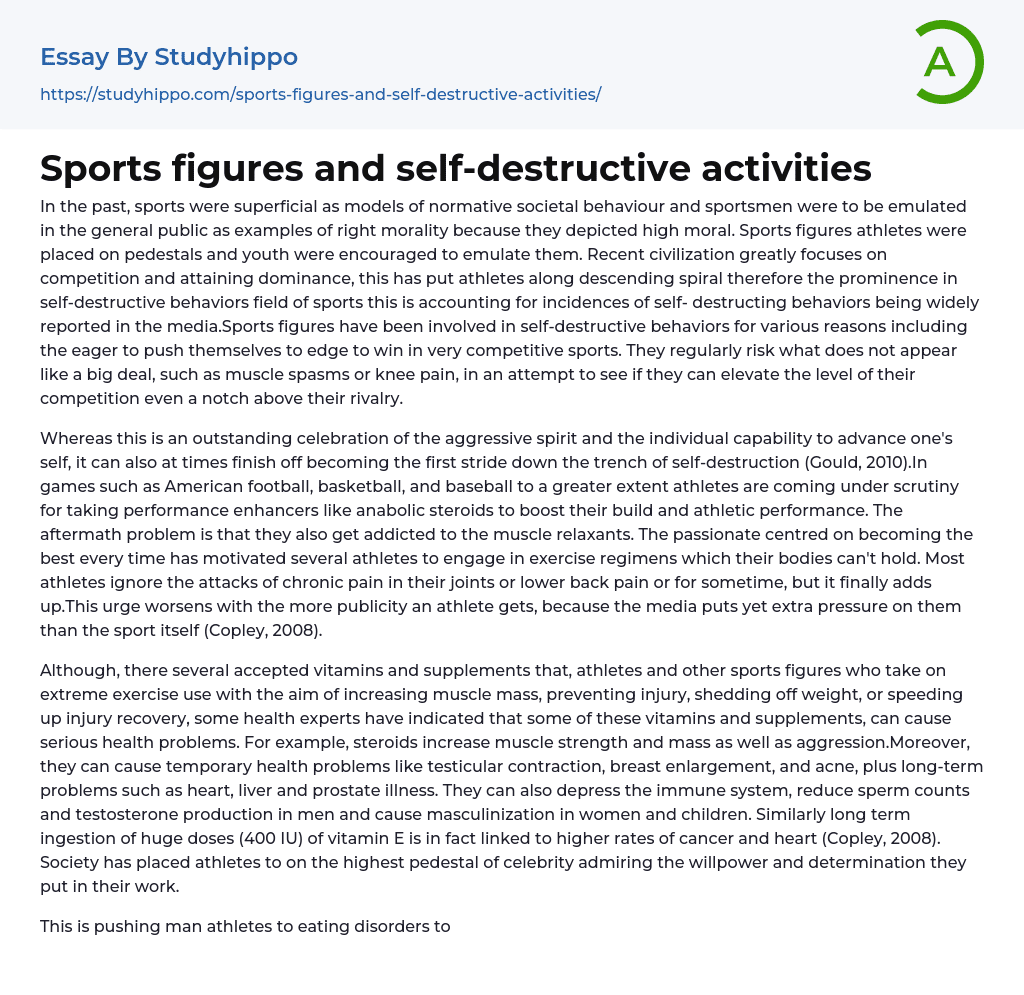

Sports figures and self-destructive activities Essay Example
Previously, athletes were seen as exemplary figures in society and praised for their ethical behavior. They were highly regarded and youth were motivated to emulate them. Nevertheless, the current competitive culture has resulted in athletes participating in harmful actions that are often publicized by the media. These actions arise from a need to surpass personal boundaries and triumph over opponents, even if it involves hazards such as disregarding muscle spasms or knee discomfort.
in such as lower back pain is often disregarded until it reaches a critical point. The media's scrutiny only amplifies this drive and intensifies the pressure on athletes <(Copley, 2008)>.
Although athletes and sports figures often employ vitamins and supplements to increase muscle mass, prevent injury, lose weight, or aid in injury recovery, some health experts caution against potential serious health complications that may arise from their use. For instance, steroids can boost muscle strength and mass along with aggression; nevertheless, they may also cause short-term problems such as testicular contraction, breast enlargement, and acne. Furthermore, steroids could lead to long-term complexities like heart disease or illnesses affecting the liver or prostate. Immune system depression with reduced sperm counts and testosterone production in men while leading to masculinization in women and children are also possible side effects of steroid use.
I
addition to these risks associated with supplement usage by athletes for enhancing performance or physique; society regards them highly due to their unwavering determination during competition despite concerns about potential harm caused to their overall wellbeing. However taking high doses (400 IU) of vitamin E over an extended period has been linked with elevated cancer and heart disease rates (Copley 2008).
The phenomenon of athletes developing eating disorders in order to maintain public adoration is a growing trend. Certain sports, such as swimming, which require revealing clothing can lead to an unhealthy preoccupation with appearance causing the female athlete triad – a syndrome that includes amenorrhea and osteoporosis caused by low estrogen levels and poor nutrition. It should be noted that this issue affects not only female athletes but women are more vulnerable to it. Athletes who are at the highest risk have specific risk factors including excessive participation in sports with limited social activities, external pressure from coaches or parents to lose weight, training outside of scheduled practice times despite illness or injury, poor performance, injury or changes in coaching staff (Copley, 2008).
Participation in certain sports can be highly perilous for athletes, particularly those that emphasize physical appearance. These sports include gymnastics, cheerleading, synchronized swimming, and ballet. Additionally, other sports prioritize characteristics like leanness and stamina or involve evaluation rather than refereeing; these include figure skating, diving, and gymnastics which also carry risks. In particular, men are notably susceptible to developing eating disorders when engaging in the "weight cutting" subculture of certain competitions which seek to qualify or gain a competitive advantage; track and field as well as wrestling fall into this category. Lightweight rowing
is another sport that places males at significant risk of unhealthy weight loss behaviors and eating disorders (Copley, 2008).
Self-aggression among sports figures in combat sports has been on the rise, despite these sports being designed to promote self-control, discipline, and defense. Athletes participating in boxing, ju-jitsu, judo, karate or tae-kwondo have displayed this behavior due to various reasons such as frustration, accumulated anger, an urge to exceed expectations or defeat opponents. However, it is complicated and unclear if cause-effect relationships are responsible for this behavior. A higher level of testosterone may lead boxers to become more aggressive while an intense desire to win can push athletes towards using violent tactics including injuring or killing their opponents.
According to Gould (2010), some sports figures have engaged in disrespectful verbal exchanges that diminish their dignity. Overall, self-destructive behaviors among athletes stem from both the desire to outperform competitors and the stress of meeting societal, familial and coaching expectations. If not managed properly, feelings of frustration can lead to harmful practices. Additionally, athletes may feel pressured to exceed expectations given their elevated celebrity status in society. Lastly, the type of sport may also influence the development of self-destructive tendencies.
- Anatomy and Physiology essays
- Addiction essays
- Biodegradation essays
- Dental Care essays
- Disease essays
- Disorders essays
- Health Care essays
- Intelligence Quotient essays
- Nutrition essays
- Olfaction essays
- Public Health essays
- Women's Health essays
- World health organization essays
- Cancer essays
- Infectious Disease essays
- Lung Cancer essays
- Neurology essays
- Physical Exercise essays
- Medicine essays
- Sex essays
- Inquiry essays
- Disability essays
- Poison essays
- Action Potential essays
- Nervous System essays
- Childbirth essays
- Puberty essays
- Blood essays
- Kidney essays
- Neuron essays
- Body essays
- Glucose essays
- Sense essays
- Heart essays
- Skeleton essays
- Human Physiology essays
- Eye essays
- Immune System essays
- Muscle essays
- Skin essays
- Brain essays
- Central Nervous System essays
- Human Skin Color essays
- Digestive System essays
- Common sense essays
- Respiration essays
- alcoholism essays
- Smoking essays
- Casino essays
- Tobacco essays



